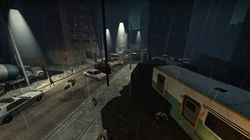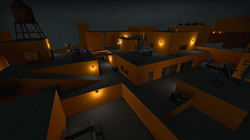


Red City
Goal of the Project
The goal of this project was to broaden my skills as a level designer by creating a compelling co-op experience in Left 4 Dead 2. The game was an ideal platform to design for, as its four-player cooperative gameplay made in-house playtesting practical and efficient. However, due to the nature of multiplayer design, playtesting was critical to shaping a fun and engaging campaign.
In the early phase of development, I tested the scale and proportions of the whiteboxed level through in-house playtests with peers. This was followed by focused gameplay testing sessions, where I gathered feedback on flow, difficulty, and overall fun. After several internal iterations, I released Red City to the online community via the Steam Workshop and GameMaps. I actively engaged with players, reviewed community feedback, and used it to refine and improve the campaign throughout development.
Campaign Overview
-
Name: Red City
-
Game: Left 4 Dead 2
-
Type: First Person Shooter/Co-op Multiplayer
-
Engine: Valve Hammer Editor
-
Development Time: 14 weeks
-
Number of Levels: 2
Level Summary
The Red City is a standalone mini-campaign of the critically acclaimed shooter, Left 4 Dead 2. The campaign comprises of two levels and supports a total gameplay of 20 minutes. The urban theme of the campaign places the survivors in the middle of a zombie-infested city. The survivors’ ultimate objective is to get to higher ground where they had earlier seen a helicopter fly through. Their journey begins on the city street from where they make their way to the roof of the tallest building.
The first level takes the survivors into a city street infested with zombies before forcing them to make a run for the safe room through a narrow alley way. The second level moves the survival battle to the roofs of the city buildings. The players must jump between multiple rooftops while fending off zombies before they get to the end of the level, i.e., the rescue zone.
Campaign Information
Level 1 - Red Street
Key Design Points
Playthrough Video
Screenshots
-
U-Shape Flow
-
This allowed the designer to use one side of the playable map as a vista for the other side and vice-versa.
-
It helped speed up the visual decoration process for the designer as decorating one side of the U-shape helped build the vista for the other side.
-
It created a cool effect and added an intrinsic feel to the level when the players found themselves looking back at an area they just walked through.
-
-
Interior and exterior movement
-
The level keeps the players alternating through narrow and wide areas. This ensures that the survivors are on their toes and makes the level more interesting.
-
The level also provides players with various pathing options encouraging exploration and replayability.
-
 |  |  |
|---|---|---|
 |  |  |
 |  |  |
 |  |  |
Level 2 - Red Roofs
Key Design Points
Playthrough Video
Screenshots
 |  |  |
|---|---|---|
 |  |  |
 |  |  |
 |  |
-
Narrow pathways connecting the multiple rooftops forces tense situations where special infected have the opportunity of pushing the players off the roof to their deaths.
-
The design of the finale ensures that the each play through provides a unique experience. The finale generators that turn off are randomized for each game.
-
Verticality in the gameplay space has been heavily incorporated into the design of the rooftops.
-
The level provides players with various pathing options and contains key spots where clever and skillful players are rewarded with progression for perfect maneuver executions.
Key Challenges
Balancing Difficulty
Lessons learnt from the previous projects highlighted the importance of optimizing a level and how it majorly affects player experience. More importantly, as the aim of this project is to share the campaign with the online community, I had to ensure that the level ran at a decent framerate on most machines.
For the optimization step, I used
-
Area portals
-
Occluders
-
Visleaf manipulation with hint/skip
-
Fog clipping.
The videos below compare the number of assets drawn by the engine during gameplay, before and after optimization.
Balancing the various difficulty options provided within the game while ensuring that the modification made to the game’s AI Director Script does not completely throw the overarching balance of the game was challenging.
To find a solution, I watched the Red City playthroughs of numerous Left 4 Dead 2 players at various game difficulty levels and learnt to ‘predict’ the outcome difficulty based on the AI values entered into the script. With many minor and major tweaks to the AI Director Script, the levels currently play close to the difficulty standards set by Left 4 Dead 2 while ensuring it maintains its unique Red City gameplay.
Optimized